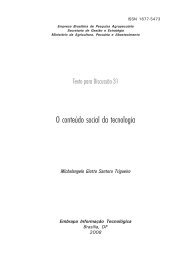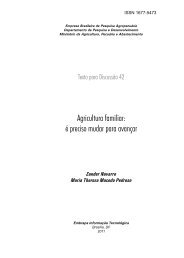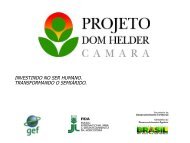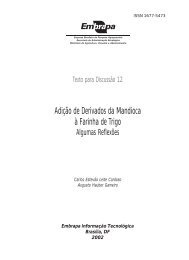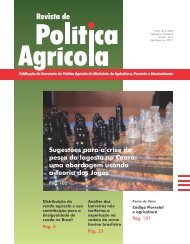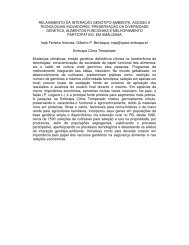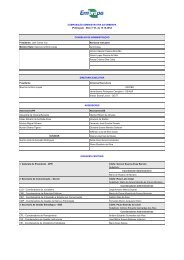Ministry of Agriculture, Livestock and Food Supply - Embrapa
Ministry of Agriculture, Livestock and Food Supply - Embrapa
Ministry of Agriculture, Livestock and Food Supply - Embrapa
Create successful ePaper yourself
Turn your PDF publications into a flip-book with our unique Google optimized e-Paper software.
The anaerobic digestion process (biomethanization) consists in metabolizing<br />
a complex <strong>of</strong> organic matter by a mixed culture <strong>of</strong> microorganisms to produce<br />
methane (CH ) <strong>and</strong> carbon dioxide (CO ) <strong>and</strong> cell material (LUCAS JUNIOR,<br />
4 2<br />
1994; SANTOS, 2001). The organic matter includes carbohydrates, lipids <strong>and</strong><br />
proteins. Anaerobic digestion in biodigesters is the most viable process for the<br />
conversion <strong>of</strong> swine <strong>and</strong> poultry residues into thermal or electric power.<br />
The main use <strong>of</strong> rural biodigesters in Brazil has been in rural sanitation,<br />
its byproducts being biogas <strong>and</strong> bi<strong>of</strong>ertilizers.<br />
Biogas is a gaseous fuel with a high energy content, similar to natural gas,<br />
<strong>and</strong> constituted mainly <strong>of</strong> short- <strong>and</strong> linear-chain hydrocarbons. It can be used to<br />
generate electric, thermal or mechanical energy in the farms, thus helping to<br />
reduce production costs.<br />
The biomethanization process involves the anaerobic conversion <strong>of</strong><br />
biomass into methane. The biological decomposition <strong>of</strong> organic matter can<br />
be divided into four phases: hydrolysis, acidogenesis, acetogenesis, <strong>and</strong><br />
methanogenesis. This conversion <strong>of</strong> an organic complex requires a mixture<br />
<strong>of</strong> bacterium species <strong>and</strong> can take place through a sequence <strong>of</strong> the<br />
aforementioned reactions.<br />
There are three types <strong>of</strong> treatment <strong>of</strong> organic residues depending on<br />
the temperature used in the process. Biomethanization, wherein the<br />
temperature varies from 45ºC to 60ºC, is considered a thermophilic process.<br />
Treatments at temperatures varying from 20ºC to 45ºC are mesophilic. The<br />
anaerobic digestion <strong>of</strong> organic matter at low temperatures (> 20ºC) is<br />
psychrophilic.<br />
Anaerobic conversion produces a relative small amount <strong>of</strong> energy for<br />
the microorganisms, so that their rate <strong>of</strong> growth is reduced <strong>and</strong> only a limited<br />
part <strong>of</strong> the residue is converted into new cell biomass. Figure 13 shows a<br />
simplified scheme <strong>of</strong> the metabolic phases (SANTOS, 2001):<br />
The presence <strong>of</strong> steam, CO 2 <strong>and</strong> corrosive gases in raw biogas is the<br />
main obstacle to biogas storage <strong>and</strong> to energy production from biogas. The<br />
useful life <strong>of</strong> sophisticated equipment – such as combustion engines,<br />
generators, pumps, <strong>and</strong> compressors – is extremely shortened. Control<br />
equipment – such as thermostats, pressure gages <strong>and</strong> flow gages – is also<br />
attacked, not only reducing their useful life, but also making them unsafe <strong>and</strong><br />
unreliable. It is essential to remove the water, CO 2 , sulfur dioxide, sulfur, <strong>and</strong><br />
other elements by means <strong>of</strong> filters <strong>and</strong> devices for cooling, condensing <strong>and</strong><br />
washing the gas in order to ensure the reliability <strong>and</strong> use <strong>of</strong> the biogas.<br />
96



